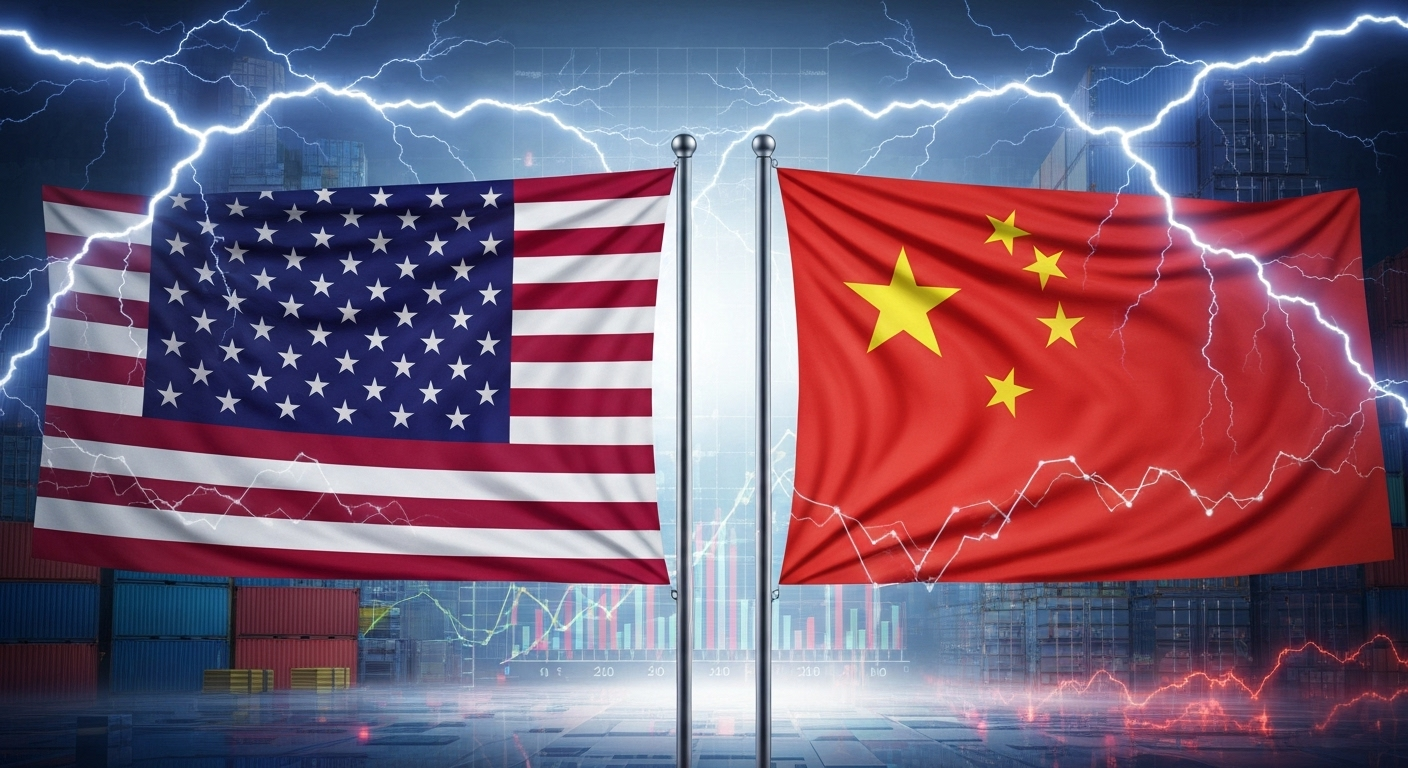Key Highlights
Here are the key takeaways from the recent trade announcement:
- President Donald Trump revealed plans for an additional 100% tariff on Chinese imports, bringing the total tariff to 130%.
- This move is a direct response to China imposing new export controls on its rare earth minerals.
- The announcement triggered immediate fears of a renewed trade war, causing major stock indexes to fall sharply.
- In addition to tariffs, Trump announced upcoming export controls on “any and all critical software” to China.
- China’s Commerce Ministry has stated it will take firm countermeasures if the United States proceeds.
Introduction
The fragile trade truce between the world’s two largest economies has shattered. In a surprising move, President Donald Trump announced a massive escalation in the trade conflict, planning to hike tariffs on goods from China to a staggering 130%. This decision, shared via a post on Truth Social, comes after a period of relative calm and threatens to reignite a full-scale trade war. The announcement has sent shockwaves through global markets and left businesses and consumers bracing for impact.
The Details Behind Trump’s 130% Tariffs on China
The new tariffs represent a sharp pivot in trade policy. President Donald Trump declared that an additional 100% tariff will be placed on Chinese goods, on top of the 30% already in place. This move effectively ends the trade truce that had brought some stability to the markets.
The catalyst for this decision appears to be Beijing’s recent move to ramp up export controls on its rare earth minerals. In response to the tariff threat, China’s Commerce Ministry has already promised to take “corresponding measures,” signaling that the tariff war is far from over. What does Trump’s 130% tariff on China mean for global trade? It suggests a return to a tit-for-tat battle that could disrupt supply chains worldwide. Let’s explore which sectors are most vulnerable and the official reasons behind this action.
Which Products and Sectors Are Most Impacted
While a 130% tariff will affect nearly all Chinese imports, certain industries are positioned to feel the impact more acutely than others. These sectors rely heavily on Chinese manufacturing and components, making them particularly vulnerable to such a drastic price hike. Have you considered how this might affect the products you use every day?
The sectors expected to be most affected by the 130% China tariffs include:
- Tech and Electronics: This includes consumer goods like smartphones and components for advanced technology.
- Apparel and Furniture: These are among the top categories of goods the United States receives from China.
- Automobiles: The auto industry relies on a global supply chain, including many parts and minerals from China.
The tech industry, in particular, is in a precarious position. Many electronics are assembled in China, and the country is a primary source of the rare earth elements needed for their production. Although the Trump administration previously issued exemptions for electronics, this new, aggressive stance suggests that tech companies may not be spared this time, potentially leading to significant disruptions and higher costs.
Official Reasons for Imposing New Tariffs
Has the US government given reasons for imposing such high tariffs now? Yes, the official justification points directly at Beijing. In his announcement, President Trump cited what he called China’s “extraordinarily aggressive position on Trade.” He specifically referred to China’s new export controls on rare earth minerals as a “moral disgrace” and a hostile act toward the global community.
This escalation, however, did not come out of nowhere. Tensions have been simmering for months. A key part of past trade agreements was ensuring China would increase its supply of rare earth magnets, but Trump has repeatedly accused China of not holding up its end of the bargain. This led to earlier US restrictions, such as those placed on a key Nvidia AI chip.
From Beijing’s perspective, the new rules are a “legitimate move.” A spokesperson for China’s Commerce Ministry accused Washington of employing “double standards,” noting that the U.S. has long used its own export controls to restrict the sale of American technologies to China. They argue that their actions are a response to a series of restrictive measures from Washington, creating a cycle of countermeasures.
Economic and Market Reactions in the United States
The reaction from the financial markets in the United States was swift and severe. Following Trump’s announcement on Friday, investors rushed to sell, driven by fears of a repeat of the damaging tariff battles from the past. This uncertainty immediately erased recent market gains and highlighted the economic fragility of the U.S.-China trade relationship.
How are stock markets reacting to Trump’s China tariff announcement? The Dow Jones Industrial Average plummeted by 878 points, a 1.9% drop. The S&P 500 fell 2.7%, and the tech-heavy Nasdaq tumbled a significant 3.5%. This sharp downturn shows just how worried Washington and Wall Street are about the potential for another prolonged trade dispute. Next, we will examine how specific industries are responding and what this could mean for your wallet.
How Stock Markets and Industries Are Responding
The fear of a renewed, intense trade war sent stock markets into a sharp decline. Investors are clearly rattled by the unpredictability, as the announcement of massive new tariffs came after months of relative calm. This sudden shift has created significant anxiety, leading to a major sell-off as markets closed on Friday.
The immediate impact was clear across the major indexes. The numbers reflect widespread investor concern about corporate profits and economic growth in the face of escalating trade tensions.
| Market Index | Points Down | Percentage Drop |
|---|---|---|
| DOW | 878.82 | 1.90% |
| S&P 500 | 182.60 | 2.71% |
| NASDAQ | 820.20 | 3.56% |
Beyond the stock markets, industries are bracing for disruption. The tech sector, which saw the Nasdaq fall the most, is especially on edge. Companies remember previous retaliatory actions, like special port fees on ships and restrictions on firms like Nvidia, and anticipate that this new round of tariffs will bring similar, if not more severe, challenges to their supply chains and operations.
Potential Price Effects for US Consumers
Are US consumers likely to see price increases after these tariffs? The short answer is almost certainly yes. Tariffs are taxes on imported goods, and companies that import products from China will face a massive cost increase. Historically, these costs are often passed directly down to the consumer in the form of higher prices.
You can expect to see potential price increases on a wide range of everyday items. Some of the most affected categories will likely be:
- Electronics: Everything from smartphones to laptops could become more expensive.
- Apparel and Furniture: As top Chinese imports, these goods will likely see significant price hikes.
Although US President Donald Trump has encouraged companies to shift global production and manufacturing to America, the nation’s economy still depends heavily on hundreds of billions of dollars’ worth of Chinese imports. A 130% tariff makes these goods dramatically more expensive for American companies to buy. To protect their profits, businesses will likely raise the prices you pay at the checkout counter.
Conclusion
In summary, Trump’s announcement of a 130% tariff on Chinese goods is stirring significant trade concerns that reverberate throughout the economy. As we analyzed, various sectors and products stand to be affected, prompting widespread reactions from both the market and consumers. The implications of these tariffs could lead to higher prices for everyday products, potentially altering consumer behavior and spending patterns. It’s crucial to stay informed and understand how these developments might impact your financial landscape. As the situation evolves, keep an eye on updates to navigate the changing economic environment effectively. If you want personalized insights or support on how to adapt to these changes, feel free to reach out for a consultation!




